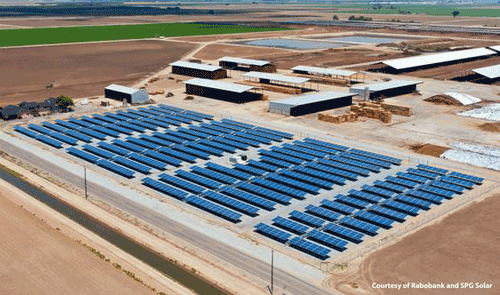It's just a tiny trickle so far, but solar power projects are slowly beginning to pop up on Western dairies. The latest one to begin generating electricity for the power grid is a big one, more than 200 times the size of installations typically seen on houses.

The project is at Lakeside Dairy, a 7,000-head and 1,000-acre operation near Hanford, Calif., that is operated by Mike Monteiro and his family. Rather than being mounted on roofs like home setups are, their photovoltaic solar panels are mounted on stands on the ground. A total of 3,240 modules are grouped into 104 panels that cover about 4 acres next to the commodity area. The system's electricity-generating capacity is 891 kilowatts; most home systems are about 4 kW.
Opened in February, the cost of the project was $3.5 million, which was financed by Rabobank, N.A. Estimated payback time, including state, federal, and local utility company incentives, is seven years. Monteiro calls the decision to build the system "a no-brainer." When it is paid off, he estimates the system will cut his electricity bill from about $22,000 per month to just $3,000.
Besides a fast payback time, almost no maintenance needs, and no waste production whatsoever, Monteiro says solar technology was more appealing to him than manure digesters for one simple reason: not having to deal with the San Joaquin Valley Air Pollution Control District. Producers have found it increasingly more difficult to obtain permits for such installations, and some have even been fined for pollution violations when they use their digesters' methane gas to run generators that make the electricity.

The project is at Lakeside Dairy, a 7,000-head and 1,000-acre operation near Hanford, Calif., that is operated by Mike Monteiro and his family. Rather than being mounted on roofs like home setups are, their photovoltaic solar panels are mounted on stands on the ground. A total of 3,240 modules are grouped into 104 panels that cover about 4 acres next to the commodity area. The system's electricity-generating capacity is 891 kilowatts; most home systems are about 4 kW.
Opened in February, the cost of the project was $3.5 million, which was financed by Rabobank, N.A. Estimated payback time, including state, federal, and local utility company incentives, is seven years. Monteiro calls the decision to build the system "a no-brainer." When it is paid off, he estimates the system will cut his electricity bill from about $22,000 per month to just $3,000.
Besides a fast payback time, almost no maintenance needs, and no waste production whatsoever, Monteiro says solar technology was more appealing to him than manure digesters for one simple reason: not having to deal with the San Joaquin Valley Air Pollution Control District. Producers have found it increasingly more difficult to obtain permits for such installations, and some have even been fined for pollution violations when they use their digesters' methane gas to run generators that make the electricity.







